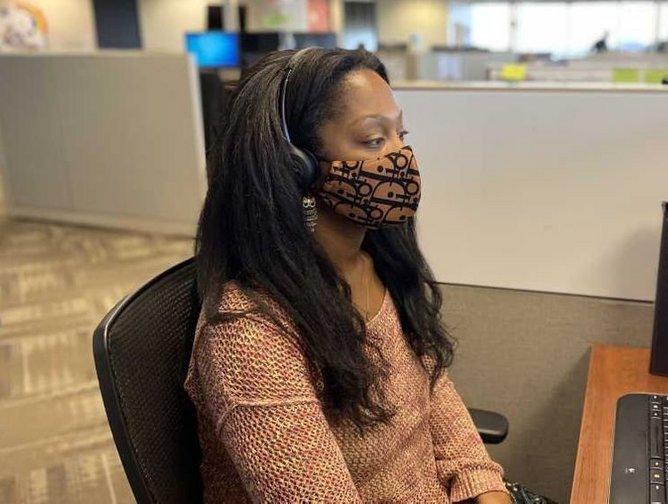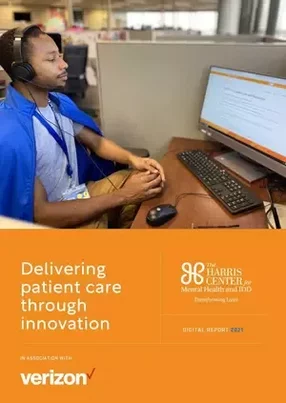“The biggest thing that drives us is our mission, which is to transform the lives of people with behavioral health and IDD needs" Young says. "Everything comes back to that - how we’re trying to meet the needs of our community, the individuals that are receiving our services, and in some cases, those individuals that need our services, but haven't found their way to us yet.”
Technology, and going through a digital change, seemed like a clear way to achieve this goal. “The concept of transformation exists throughout our organization, and digital happens to be a part of it. It seemed intuitive to us that if we're radically rethinking how we meet the needs of our community, that we lend a fair amount of consideration to technology and digital approaches to meet those needs.”
“As a fairly traditional public mental health system, it's been a bit of a journey, but we’ve made significant inroads. Our CORE program is one of these efforts.”
“CORE is the Clinician and Officer Remote Evaluation program we implemented in collaboration with the Harris County Sheriff’s Office. At its most basic element, the program uses a HIPAA-compliant technology platform to connect law enforcement officers with a crisis mental health clinician at the time of a 911 dispatch to a call with a mental health component to it.Our crisis clinicians provide support, clinical assessment and recommendations on appropriate call resolution.”
To do this the Harris Center equipped law enforcement partners with tablets,and launched the program as a year-long pilot in 2018. “We've had some really tremendous outcomes” Young says. Law enforcement partners have noted decreased utilization of emergency rooms, improved decision making, reduced time on calls, and identification of alternative resources as just of a few of the benefits of the program. “When officers are dispatched they may or may not have any idea that there’s a mental health component influencing what's happening with that 911 call. With a tablet they literally have to click one or two icons to connect to our crisis clinicians via a telehealth system.”
This enables clinicians to carry out a crisis assessment in real time with the individual involved, helping both them and law enforcement decide what the next step is, and whether it’s necessary to send further community based supports such as a mobile crisis team, or if a hospital visit is required.
CORE has been tremendously successful - less than 1% of the individuals involved in response calls in the pilot ended up going to jail. “We were able to find alternative responses, and what initially looked like a 911 police call turned into an opportunity to provide the person with support and services.”
The next phase is to expand the program so that around 200 tablets are made available to Harris County’s law enforcement officers and first responders. Young explains why this next phase is important: “Law enforcement want to do a good job and they understand the mental health implications, but they sign up to be police officers, not mental health counsellors. How we leverage our expertise, and make that expertise available to them, is critical.”
“Sometimes there's a safety component - there are times when law enforcement responds to mental health calls and there are outcomes that are less than desirable. One quarter of police-involved shootings are linked to mental illness, half of which occur in the person’s own home. So it’s thinking about how we provide them with the tools to deal with these situations and have a safe outcome for both the officer and the individual that's the subject of the call. Ultimately we want to get them care and support, as opposed to an arrest or being put in jail.”
The program’s elements are HIPAA-compliant, and they’ve leveraged the capabilities of Verizon and Lifesize to facilitate it. “When we first set out to start CORE it was a concept at best. We had questions about connectivity, about whether the tablets would work, whether we’d be able to see people at night or if we would be able to hear people next to busy roads.” Young explains.
“We wanted to build on our learnings, so in those early phases we would literally reach out to Verizon and say, ‘we had a call in this area and the signal wasn't very strong, how do we boost that, and can you help?’ They were always responsive. The interface needed to be simple for an officer to use out on the road, and we needed to be able to do a crisis assessment in the middle of a shopping center for instance. It can’t be complicated.”
“Our partners were willing to come alongside us when the concept of a real time mental health crisis response in partnership with law enforcement was unproven and unconventional. They've been tremendous - collaborative, responsive, and scalable.”
Young explains the medium of telehealth is well suited to behavioral health care. “It requires significantly less physical evaluations than other forms of healthcare. Talk and interactions are critical and the assessment process relies more on communication than traditional physical assessments. Our usage of telehealth as a platform for service delivery has gone up exponentially since the pandemic began. We operate a lot of community-facing emergency crisis services that still have to be in-person, but we pivoted a large number of people to work remotely very quickly.
“We’ve developed some best practices around how to do this well, because we want to keep a close eye on people who are not receiving home visits any more due to the pandemic. For those we are currently serving, people have maintained a pretty healthy trajectory and we're not seeing dramatic increases in needs for crisis services than usual. However, we have seen a sharp (15%) rise in the mental health utilization across Houston due to the impact of the pandemic. We have relied upon telehealth to increase our capacity so that we could serve more people during this challenging time.”
Delivering consultations virtually is also enabling them to reach more people. “It's more accessible for some people,and makes outreach easier” Young says. “But there are also some challenges, for instance not everyone has broadband access, and many of the people we serve have pre-paid cell plans which makes it a challenge for them to use a significant amount of minutes on telehealth services. We’re having to think about how we work with strategic partners to improve access so we can continue delivering this type of care.”
They are also considering the long-term impact of the pandemic, in terms of social isolation and the lack of connectedness most people are experiencing. “To support our community during these difficult times, we operate a statewide COVID-19 support line for Texas Health and Human Services Commission. We get calls every day from people that maybe aren't in crisis, but need to talk to someone. We're seeing that impact across our communities - individuals who may not have previously had a mental health concern, but are being impacted by the environment we're in. I think we're all impacted by it to some degree, it just depends how connected we are to support in our communities and how effective that support is in helping us manage this really challenging time.”
In the next few years, one of their strategic priorities is to deliver "care anywhere". "It won't be long before most people want to receive care, particularly behavioral health care, delivered through their cell phone, and we need to respond to that demand.
There is a reason that behavioral healthcare has more no shows than other types of healthcare. People often disengage from treatment and one factor is about convenience and responsiveness. We've got to turn this on its head and be responsive. We've now proven we can be agile and we can get really creative about it - my vision is for us to provide care in a variety of different formats and locations to meet people's needs in the way they want us to. Technology and digital health will support that vision."




